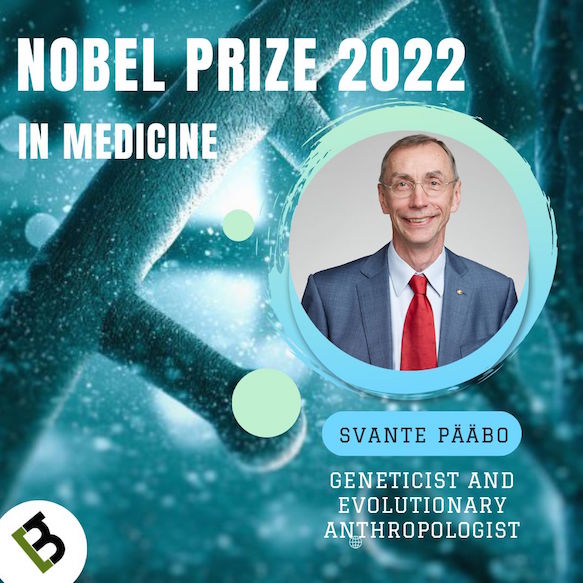Svante Pääbo received a call on 3rd october 2022 from Adam Smith, the Chief Scientific Officer of Nobel Prize Outreach. Over the phone, Adam announced the results of the Nobel Prize for 2022 in the field of Medicine. You can listen to the engaging and motivational telephonic conversation here.
As we all know that the Nobel Prize is distributed every year since 1901. The prizes are distributed in the field of Physics, Chemistry, Medicine or Physiology, Literature, and Peace. Being a Life Science learner and a blogger, I am sharing and writing a brief article on Svante Pääbo, a geneticist and evolutionary anthropologists who has won the Nobel prize in the field of medicine for this year. He received the Nobel prize for his exceptional contribution in studying fossil DNA of ancestral humans. His remarkable work has led the foundation of Paleogenomics. This discipline will allow us to explore and understand the genetics of humans who lived on Earth ten thousand years ago. It will also empower us to decode how today’s modern humans have been developed from Neanderthals and ancient hominins. By comparing and finding the similarity and differences between the genomes of modern and old homosapiens we will get to know who we are and how we have been developed.
Brief Profile of Svante Pääbo –
Svante Pääbo accomplished his Ph.D. from University of Uppsala, Sweden in 1986. He further completed his one year Post Doctoral research from the Institute for Molecular Biology, University of Zürich, Switzerland. Later, he joined the Imperial Cancer Research Fund, London, UK for a short period of time. Furthermore, he conducted 3 years of post doctoral research at Department of Biochemistry, University of California at Berkeley, USA. He had also worked in University of Uppsala, Sweden and University of Munich, Germany. Since 1997 he is working as the Director at Max Planck Institute for Evolutionary Anthropology, Leipzig, Germany.
Contribution of Svante Pääbo-
DNA extraction from living plant, animal, and microbes are conducted on a daily basis in the life science laboratory. Extracting DNA from fossil bones is strenuous and laborious due to the fragile nature of ancient DNA. The ancient genome, when extracted, is in the form of small fragments. It is highly prone to degradation and contamination due to soil and environmental conditions. While extracting fossil DNA, the process is susceptible to microbial contamination which may lead in difficulties in distinguishing microbial and fossil DNA. The Pääbo’s team was also aware that this long duration had possible caused fragmentation and modification of nucleotides.
Svante Pääbo spend half of his life time in studying and developing the novel technique to extract the fossil DNA. Pääbo selected mitochondria DNA over nuclear DNA because in every cell there are hundred to thousand copies of mitochondria. Hence, extracting mitochondrial DNA had a greater chance of extracting mitochondria DNA than nuclear DNA. After extracting, the team used hyper-variable part (105bp) of mitochondrial DNA as primer and amplified the extracted DNA fragments. The amplified fragments were cloned and sequenced.
Further the team read the broken DNA to reconstruct the original genomic content. While conducting the research, Svante Pääbo and his colleagues extracted and analyzed genomes of Neanderthals and Denisovans from their fossils. Their study showed that we the modern humans have similarities with both Neanderthals and Denisovans. It indicates that Neanderthals and Denisovans have intermingled with each other and forming primitive modern humans. The offsprings received genetic characteristics from both the lines. This could be witnessed by stronger immunity against pathogenic attack in certain modern human population. The ability of contemporary Tibetans to survive in high altitudes is derived from gene called EPAS1 of Denisovans.
Svante Pääbo and his colleagues also disclosed that the genetic legacy received from our ancestors could still affect our modern human’s physiology. In 2020, the team found that in certain modern human population, the ancestral genes lead to the respiratory failure during Corona infection. However, in 2021 the team also found that ancestral genes protected the certain modern human population of another region.
Neanderthal fossil were discovered in 1856 and from then the scientific community was trying to understand the evolution of modern humans. They also believed that sequencing of Neanderthal genome will be impossible. But now the scientists states that due to the incredible work of Svante Pääbo the understanding of human evolution will be accelerated.
Who were Neanderthals and Denisovans?
Four lakh years ago, the early humans who lived in Europe and Western Asia are called Neanderthals. They became extinct about forty thousand years ago. The other human population who lived in Asia were called Denisovans. These both the geographical separated ancestral human species were distinct. Svante Pääbo and his team isolated DNA from both the fossils and discovered our genetic relatedness with Neanderthals and Denisovans. The scientist are still deciphering the reasons for the extinction of Neanderthals and Denisovans and flourishing of offsprings.
Conclusion –
The scientific community believes that the exceptional work of Svante Pääbo would intensely influence our understanding the human evolution. Such inspiring work will really motivate young scientific minds to explore DNA sequencing of fossils across the globe. Svante Pääbo’s work is a milestone in the field of Archeogenetics.
References –
https://www.nobelprize.org/prizes/medicine/2022/advanced-information/
https://www.eva.mpg.de/genetics/staff/paabo/
Dr. Sangha Bijekar has 9 years of Teaching Experience at University level. She loves to get engage in teaching and learning process. She is into blogging from last two years. She intends to provide student friendly reading material. She is avid Dog Lover and animal rescuer. She is learned Bharatnatyam and Katthak Dancer. She is into biking and She also loves to cook.

